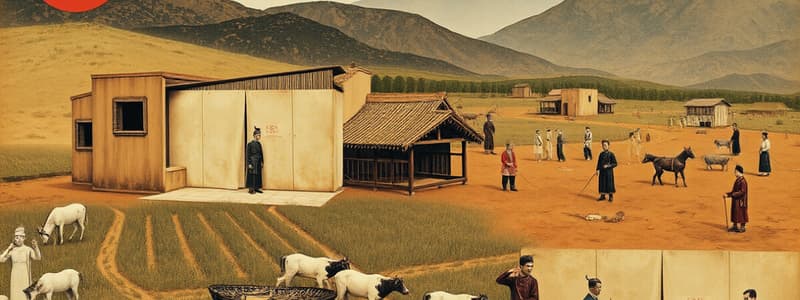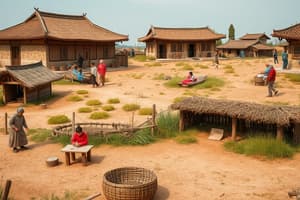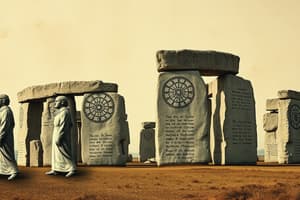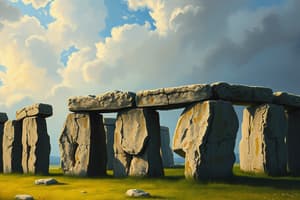Podcast
Questions and Answers
What significant change occurred for early humans in China around 10,000 BC?
What significant change occurred for early humans in China around 10,000 BC?
- They began extensive trade with neighboring civilizations.
- They developed advanced metallurgy.
- They transitioned to a sedentary lifestyle. (correct)
- They migrated to other continents.
Which of the following crops was primarily farmed by Neolithic cultures along the Yellow River?
Which of the following crops was primarily farmed by Neolithic cultures along the Yellow River?
- Rice
- Wheat
- Barley
- Millet (correct)
What natural barriers isolated ancient China from the western world?
What natural barriers isolated ancient China from the western world?
- Great Plains and Rocky Mountains
- The Sahara Desert and Atlantic Ocean
- The Himalayan Mountains and Gobi Desert (correct)
- Tropical rainforests and the Tibetan Plateau
What role did the Yangtze and Yellow Rivers play in early Chinese society?
What role did the Yangtze and Yellow Rivers play in early Chinese society?
In what way did the cultures along the Yellow and Yangtze Rivers evolve by roughly 800 BC?
In what way did the cultures along the Yellow and Yangtze Rivers evolve by roughly 800 BC?
What was the significance of the Heavenly Deity in ancient Chinese civilization?
What was the significance of the Heavenly Deity in ancient Chinese civilization?
What technological advancement is attributed to the Shang Dynasty?
What technological advancement is attributed to the Shang Dynasty?
Who was the first emperor of Imperial China?
Who was the first emperor of Imperial China?
What philosophy emphasized that humans are naturally evil and needed correction?
What philosophy emphasized that humans are naturally evil and needed correction?
Which dynasty was known for significant cultural and technological advancements during its rule, including trade along the Silk Road?
Which dynasty was known for significant cultural and technological advancements during its rule, including trade along the Silk Road?
What ultimately led to the overthrow of the Qin Dynasty?
What ultimately led to the overthrow of the Qin Dynasty?
Which philosopher's teachings were instrumental in restoring stability during the Warring States period?
Which philosopher's teachings were instrumental in restoring stability during the Warring States period?
What was the primary economic activity that differentiated Athens from Sparta?
What was the primary economic activity that differentiated Athens from Sparta?
Which of the following accurately describes the leadership of Athens during the Peloponnesian War?
Which of the following accurately describes the leadership of Athens during the Peloponnesian War?
Which event marked the beginning of Athenian democracy?
Which event marked the beginning of Athenian democracy?
What was a major consequence of Athenian naval superiority during the Greco-Persian Wars?
What was a major consequence of Athenian naval superiority during the Greco-Persian Wars?
What was the outcome of the Peace of Nicias signed in 421 B.C.E.?
What was the outcome of the Peace of Nicias signed in 421 B.C.E.?
What marked the beginning of the Eastern Han dynasty?
What marked the beginning of the Eastern Han dynasty?
Which event contributed to the decline of the Eastern Han dynasty?
Which event contributed to the decline of the Eastern Han dynasty?
What was a unique characteristic of Greek city-states?
What was a unique characteristic of Greek city-states?
What was the primary agricultural product used by the Greeks for trade?
What was the primary agricultural product used by the Greeks for trade?
Who was the first emperor of China?
Who was the first emperor of China?
Which geographical feature significantly influenced the development of Greek city-states?
Which geographical feature significantly influenced the development of Greek city-states?
What was the main purpose of the Silk Road for Han merchants?
What was the main purpose of the Silk Road for Han merchants?
What significant construction project did Qin Shi Huang initiate?
What significant construction project did Qin Shi Huang initiate?
Which form of government was unique to Athens compared to other city-states?
Which form of government was unique to Athens compared to other city-states?
What was a consequence of the geographical landscape of Greece?
What was a consequence of the geographical landscape of Greece?
Flashcards are hidden until you start studying
Study Notes
Neolithic Era and Early Chinese Societies
- Around 10,000 BC, early Chinese humans transitioned from nomadic lifestyles to settled agriculture.
- Fertile river basins of the Yellow River (Huang He) and Yangtze River provided resources and natural defenses.
- Cultures like Jiahu and Yangshao emerged along the Yellow River, cultivating millet and developing medicine and fortune-telling traditions.
- The first dynasties, Xia and Shang, arose from organized societies; Xia founded by Yu, known for flood control canals.
Cultural Identity and Geography of Ancient China
- Ancient China, located in East Asia, developed uniquely due to surrounding natural barriers, preventing outside invasions.
- Tropical rainforests limited southern expansion; cold tundra and Himalayas restricted northern influence.
- Gobi Desert, characterized by extreme climates and limited water, formed a barrier to the north.
Religion and The Mandate of Heaven
- Ancient Chinese civilization revered the Heavenly Deity, believed to grant the Mandate of Heaven for just rulers.
- Natural disasters symbolized the loss of this mandate and often preceded rebellion against unjust rulers.
Shang and Zhou Dynasties
- Shang Dynasty (1600-1046 BCE) succeeded Xia and established a complex social hierarchy with kings, nobility, and warriors.
- Known for technological advancements, particularly bronze tools and centralized governance.
- Zhou Dynasty (1046-256 BCE) evolved into Western and Eastern Zhou periods, flourishing in trade, technology, and philosophy.
- Philosophers such as Confucius and Laozi emerged during this time.
Philosophical Developments in Zhou Dynasty
- Taoism complemented Confucianism, addressing gaps in personal fulfillment.
- Legalism presented a contrasting view, emphasizing human nature's innate evil and the necessity of strict government control.
Warring States Period and Consolidation
- Breakdown of the Zhou Dynasty led to the Spring and Autumn and Warring States periods, marked by state conflict and cultural fragmentation.
- Confucian teachings aided in restoring societal stability amidst chaos.
Qin Dynasty and Legalism
- Qin Dynasty (221-207 BCE), founded by Ying Zheng (Qin Shi Huangdi), marked the beginning of Imperial China.
- Introduced standardization across military, infrastructure, and currency, driven by strict legalism.
- Qin Shi Huangdi known for significant construction projects, including the Great Wall and his tomb with terracotta soldiers.
Han Dynasty and Governance
- Established in 202 BCE by Liu Bang, the Han dynasty combined legalism and Confucianism.
- Wu Ti’s reign (141-87 BCE) expanded military conquests, trade via the Silk Road, and advancements in education and technology.
- Economic troubles and peasant unrest led to the fall of the Western Han, followed by the brief Xin dynasty, and establishment of the Eastern Han (25-220 CE).
Impact of the Silk Road
- The Silk Road connected Han China with the Roman Empire, facilitating trade but also presenting merchants with significant risks.
Ancient Greek Civilization
- Ancient Greece, located in the Eastern Mediterranean, was characterized by mountainous terrain that led to the development of independent city-states (poleis).
- Geography spurred maritime trade; primary agricultural products included olives and grapes.
Athenian and Spartan Divergence
- Distinct governmental structures: Athens had a direct democracy; Sparta operated on military oligarchy.
- Cooperation during Persian Wars contrasted with conflict in the Peloponnesian Wars.
The Peloponnesian War
- Thucydides documented the war between Athens and Sparta (431-404 BCE), caused by Athenian expansion and the Delian League.
- Key events included Pericles' defensive strategy and significant plagues that weakened Athens.
- After a series of battles, Sparta defeated Athens, leading to a decline in Athenian power.
Emergence of Athenian Democracy
- Athenian democracy evolved around 460 BCE, influenced by statesman Solon, who reformed draconian laws and encouraged trade.
- Solon's economic improvements and legal reforms set the stage for increased civic participation and governance improvements in Athens.### Athenian Democracy and Socrates
- Cleisthenes completed Athenian democracy reforms, transferring power from the Areopagus to the general assembly.
- Socrates (c. 470-399 BCE) is a key figure in Western philosophy known for his method of inquiry through question-based discussions, now termed the Socratic method.
- His trial for impiety and corrupting youth reflected the tensions in Athenian society; he was ultimately convicted despite his philosophical legacy.
- Contemporary sources include Aristophanes, Plato, and Xenophon, with Plato being the most prominent.
Plato's Contributions
- Plato (428/427-348/347 BCE) is renowned for formulating the theory of Platonic idealism, positing that true knowledge derives from ideal Forms.
- He emphasized that knowledge is accessible through reason, diverging from empirical research methods common in science.
- Advocated for a republic led by Philosopher Kings as the ideal political system, emphasizing the importance of philosophical governance.
- The Allegory of the Cave illustrates the distinction between perceived reality and true knowledge.
Alexander the Great and His Empire
- Alexander the Great (356-323 BCE), originally the king of Macedonia, succeeded his father Philip II after his assassination.
- He conquered much of the known world, including the Persian Empire, achieving significant territorial expansion.
- His campaigns spread Greek culture, known as Hellenization, by establishing Greek cities and retaining local rulers.
- Died in 323 BCE under mysterious circumstances, leading to the fragmentation of his empire among various factions.
The Library of Alexandria
- The Library of Alexandria was one of the first significant libraries, essential for document translation and preservation in the ancient world.
- Compared to modern libraries, it housed fewer written works due to the labor-intensive process of hand-copying texts.
- Established by Ptolemy I, it became a vital center for scholarship and translation in Hellenistic culture.
- It featured a mixing of Egyptian and Greek cultures through the use of Greek language and papyrus, enhancing information exchange.
Advances from Alexandrian Philosophers
- Alexandrian scholars made remarkable contributions across various fields:
- Euclid's work laid the foundations for geometry.
- Archimedes invented tools and methods influential in various sciences.
- Herophilus and Erasistratus advanced medical science through anatomical observations.
- Aristarchus proposed the heliocentric model of the solar system well before its time.
- Eratosthenes calculated Earth's circumference remarkably accurately.
- Ptolemy created a geocentric model, which, despite being incorrect, allowed predictions of celestial positions.
- The integrated knowledge from predecessors was crucial for their advancements, highlighting the significance of the Library of Alexandria as a repository of ancient wisdom.
Studying That Suits You
Use AI to generate personalized quizzes and flashcards to suit your learning preferences.




